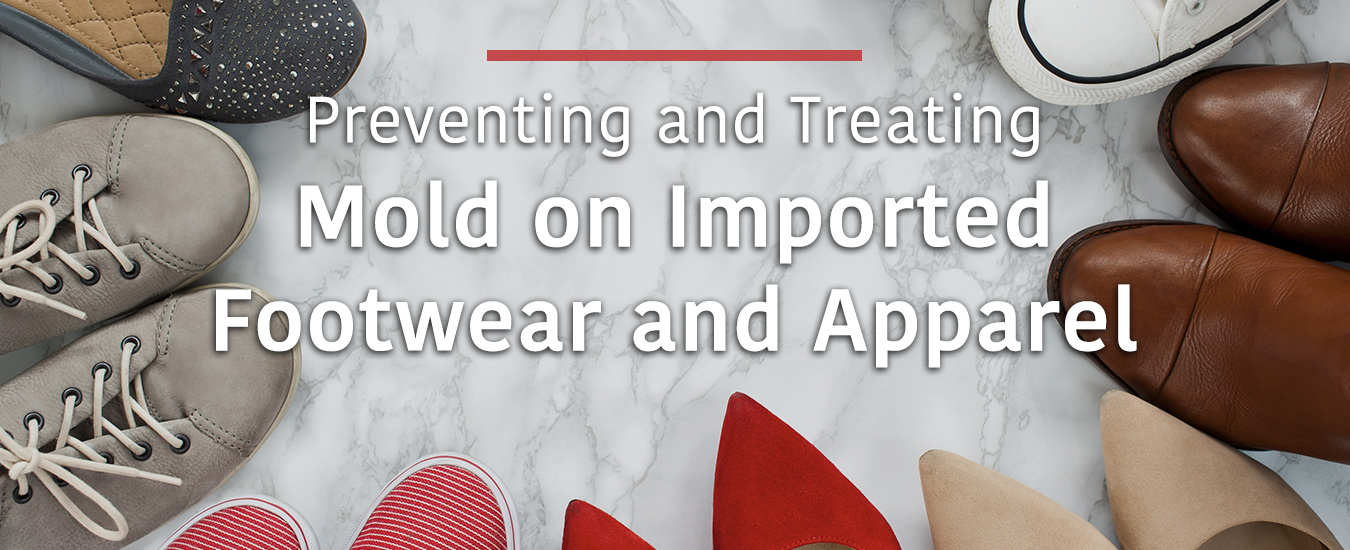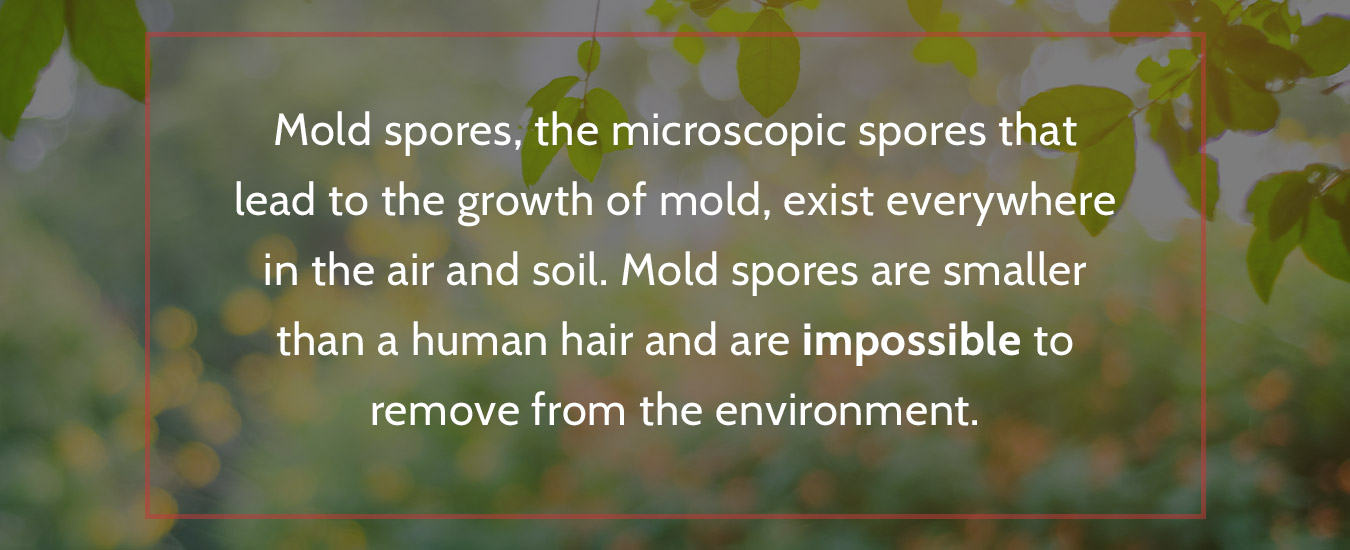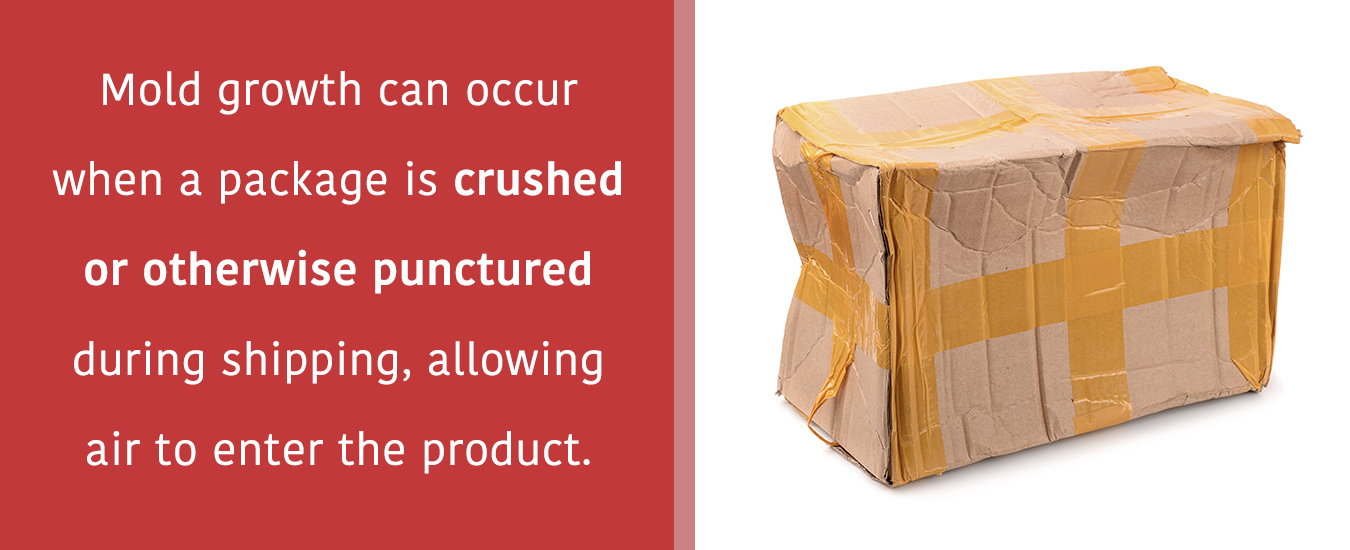Mold Prevention & Treatment on Imported Footwear & Apparel
July 22, 2020 Mold formation on imported products can be a significant challenge for distributors and retailers. When products arrive with mold damage, it can cost the importer thousands of dollars in product loss. It also sets back timelines when they must order new products to replace the damaged shipment. No importers want to deal with mold formations, but the risk is always present when they source products from overseas.
Mold formation on imported products can be a significant challenge for distributors and retailers. When products arrive with mold damage, it can cost the importer thousands of dollars in product loss. It also sets back timelines when they must order new products to replace the damaged shipment. No importers want to deal with mold formations, but the risk is always present when they source products from overseas.
Give Us a Call Now Request A Free Project Analysis
The Challenge of Mold for Importers
Mold growth occurs when imported products travel long distances and experience damp conditions. Products coming from Asia or regions with high humidity are most likely to risk mold growth. Manufacturers in these countries may not have strict regulations about warehouse conditions that can lead to moisture being trapped in the packaging. These conditions allow mold spores to start growing and then continue to spread while the product is in transit. A small amount of mold growth can spread to affect an entire shipment by the time it reaches its destination at your warehouse. Footwear and apparel are at particular risk of mold formation because they are composed of organic fibers that promote mold growth.
When products arrive with mold formation, your company is responsible for footing the costs to replace the product. Depending on how much of the product is affected, these costs can be high. On top of financial losses, these setbacks can cause damage to your reputation when you must explain to distributors or retailers why a product is not available on deadline.
Luckily, there are many steps your company can take to prevent mold growth on imported goods. When mold formation occurs, mold remediation can effectively remove mold so your products can be saved and restored to first quality. Understanding what causes mold to grow and how to prevent it is essential to avoid the costly impacts of mold formation on imported footwear and clothing.
Environmental Factors Affecting Mold Formation/Growth
Mold spores, the microscopic spores that lead to the growth of mold, exist everywhere in the air and soil. Mold spores are often smaller than a human hair — ranging from three to 40 microns in size — and are impossible to remove from the environment. Luckily, mold will only grow under the right conditions, so prevention techniques can focus on creating conditions that are not conducive to mold growth. Environmental factors that affect the growth of mold include humidity, temperature, oxygen and the presence of a food source for the fungus. When these conditions are met, mold spores will thrive and spread rapidly through your product.

Request a Free Project Analysis
Humidity: The most important environmental factor affecting mold formation is moisture. Mold requires water to grow, whether this is damp surfaces, condensation or moisture in the air. Mold grows the best in high humidity environments — however, different types of mold require different amounts of moisture to grow. Humidity and temperature also work in conjunction, with higher relative humidity in the air requiring lower temperatures to discourage the growth of mold.
Temperature: Many types of mold are capable of developing in a wide range of temperatures as long as moisture is present. However, mold grows best in warm temperatures.
Oxygen: As with other fungi, mold requires oxygen to grow. This means vacuum-sealing products can help reduce the risk of mold growth. Traditional packaging, however, provides enough oxygen for mold spores to thrive.
Food Sources for Mold: Mold can feed on almost any organic material, as one of its primary sources of nutrients is cellulose, which you can find in wood, cloth, leather, paper and anything with natural fibers. Mold is extremely opportunistic, however, and can grow on any residual organic material — such as where oil from your skin has left a mark or soap residue. This means mold can grow just about anywhere. Eliminating food sources for mold is not possible if the footwear or apparel product you’re shipping is made of natural materials. Additionally, cardboard shipping boxes and wooden pallets are also perfect food for mold. Switching to plastic pallets can eliminate one source of mold food — however, plastic pallets can be expensive and may not be readily available for the company you are importing products from.
Environmental conditions that promote the growth of mold are likely to occur when importing clothing and footwear. Many of these products are manufactured in countries with high humidity levels, such as China, Vietnam and India. Additionally, due to long transit times, mold spores have plenty of time to grow while the product is shipping. Inside these shipping containers, warm temperatures during the day cause moisture to evaporate, while cool temperatures at night cause the moisture to condensate. This cycling of warm and cool temperatures, condensation and evaporation creates “container rain” and the perfect conditions for mold to spread.
Common Types of Mold That Form on Footwear & Apparel
Footwear and apparel products are a perfect source of food for mold because they are made of organic materials, such as cotton, linen, leather and wool. These materials also hold moisture well, creating an environment that’s perfect for the growth of mold. The molds that grow on clothing and footwear are typically xerophilic fungi, a type of fungi that can thrive on low relative humidity or low levels of water. Common types of mold on clothing and footwear include Aspergillus restrictus, Aspergillus versicolor, Aspergillus sydowii, Aspergillus niger, Aspergillus glaucus and some species of Penicillium.
Aspergillus Molds
Aspergillus molds are very common and live in regions across the globe. They can survive in a wide variety of temperatures and are found in air and soil. Aspergillus molds produce a lot of enzymes, which makes them particularly efficient at destroying the cloth materials found in clothing and shoes. When Aspergillus molds grow on footwear or apparel, they can cause it to deteriorate and also give it a musty odor.
Penicillium Molds
Penicillium molds are commonly known for their usefulness against health problems in the medical field, as the fungus that penicillin comes from. However, when penicillium grows on your product, it can cause severe damage. Penicillium grows particularly well on leathers and can cause leather products to deteriorate.
Identifying Mold on Footwear & Apparel
Aspergillus molds typically appear on clothing in white, green, brown or black spots or blemishes. These spots can be tiny and hard to recognize, or mold growth can cover a large surface of the product. When found on clothing these molds are not typically fuzzy nor do they protrude from the fabric. Penicillium molds are generally easy to recognize because they appear in green, blue and yellow patches. Molds on clothing or shoes will typically appear in areas where moisture gathers, such as seams or near the soles of shoes. However, once mold growth begins, it can spread to any area of a garment or shoe. When these molds do not appear visibly, they can be identified by a musty odor on the product.

Because mold can appear in a variety of colors and patterns, it’s not always easy to identify the exact species of mold on your product. However, you should always remove mold from a product regardless of the type.
Risk Analysis on Mold Formation in Your Supply Chain
There are several areas of the supply chain at which products are susceptible to mold exposure and growth. From manufacturing to shipping to storage, it is essential to assess your import supply chain for risk of mold growth. Preventing mold from growing in the first place is the best way to avoid costly damage to your product. Performing risk analysis can allow you to identify areas susceptible to mold formation and implement techniques to help you prevent its growth.
Mold Formation Due to Lack of Climate Control
Mold growth can occur on products during manufacturing or while they’re being stored if the manufacturing center or warehouse is not well-ventilated with climate controls. Your products are at risk if the warehouse they’re stored in has high humidity levels, warm temperatures or a lack of climate control, causing the conditions inside the warehouse to fluctuate.
To best protect your product, implement climate controls to the highest degree possible. Each room of your processing center should have temperature and humidity controls. Check these controls routinely to ensure they’re working correctly and stay within the appropriate range. You should maintain climate control through every step of the supply chain, including transportation. Proper ventilation and a good HVAC system are also essential to maintain safe conditions in the warehouse. Air circulation promotes drier conditions that are less likely to allow mold to grow.
Request a Free Project Analysis
Mold Formation Due to Poor Packaging
Proper packaging is crucial in preventing mold growth. Often, the companies you’re importing shoes or clothing from will use the most economical packaging materials, rather than those that best protect your product. However, if your product is damaged during shipment, the cost may land on your shoulders. Mold growth can occur when a package is crushed or otherwise punctured during shipping, allowing air to enter the product. This can happen when cheap materials are used in packaging, as well as when a product is stacked improperly or mishandled. Mold can also occur inside of packages if the product was not dry when it was packed, typically due to poor warehouse climate control.

To ensure your products are not vulnerable to mold growth during shipping, you should set clear standards for how your manufacturer should package them. Here are a few features of packaging that are essential to prevent damage to the product and reduce the risk of mold growth during shipping:
High-Quality Cardboard: Request appropriately graded, thicker cardboard that is less likely to absorb moisture that could lead to mold growth and that will likely survive the trip from overseas to retailer distribution centers. Many types of mold love to feed on cardboard products and will quickly grow on cardboard that retains dampness. Multi-layered cardboard can also withstand more pressure, so it’s less likely to break during transport.
Nylon Bands Around Pallets: Large pallets or packages that are being stacked should always be wrapped with nylon bands. This will help prevent boxes from popping open during shipping.
Wrap Pallets in Plastic: Reinforcing pallets by wrapping them in plastic will make them easier to move and thus less likely to incur damage. The plastic will also provide an additional level of protection against moisture that allows mold to grow. Wrapping product in plastic is even more essential if the product will be exposed outdoors at any point during shipping.
Request Plastic Pallets: Wooden pallets are one of the biggest culprits of absorbing moisture and promoting mold growth. If possible, request that they use plastic pallets or slip sheets instead of traditional wood pallets.
Use Desiccants in Packaging: Desiccants are designed to draw moisture from the air to keep products dry. Products manufactured in countries with humid climates or monsoon seasons are very likely to have humidity inside of the packaging — especially if those manufacturers do not have strict climate control standards in their facilities. Desiccants will help prevent mold from growing on the product and reduce the chance of the cartons absorbing moisture. If packages become damp, they’re more likely to get crushed during transportation.
Whenever possible, enforce these standards for climate control and proper packaging to reduce the risk of mold growth on your imported products. You can opt to perform container loading inspection or other quality control inspection before the product leaves the exporting country. An inspector can ensure proper loading to reduce the risk of product damage and perform a random check to ensure the packaging includes desiccants. Taking steps to prevent mold growth will save you time and money by avoiding product loss or mold treatment.
Recovering Imported Goods Impacted by Mold and Humidity
Importers come across a variety of challenges in bringing first-quality products to U.S. markets. When sourcing goods from hot, humid, and tropical climates overseas, one of the key challenges they face annually is when monsoon season arrives.
The monsoon season, or “rainy season”, can increase the risk of mold and humidity damage to goods when above normal rainfall and high humidity is present in locations where your imported goods are made. Monsoon season generally runs between the months of April and October, although some locations experience high humidity conditions year-round.
In recent years, rainfall and temperatures have regularly exceeded normal averages. Torrential rains and flooding have been a regular occurrence. As a result, as climate conditions fluctuate from historical averages, importers should be on high alert to watch for signs of mold, moisture, and odors on their imported goods.
It is inevitable at some point that importers may encounter a shipment that has been damaged to some degree by moisture, mold, or odors. Despite best efforts by factories and importers to implement mold prevention strategies, mold clean-up is regularly required, there are always possibilities that damage can occur through no fault of their own. Products arriving at U.S. ports or distribution centers with mold and mildew can make for an unfortunate surprise that often needs to be mitigated quickly.
Fortunately, mold remediation is a service that the product rework experts at Quality Corrections & Inspections have performed for nearly 40 years.
Solutions to Mold Formation on Imported Footwear & Apparel
With nearly 40 years spent as the leader in mold remediation services, Quality Corrections and Inspections is the place to turn for your mold cleaning and treatment needs. Each year, we perform mold treatment on more than a million apparel and footwear products from top footwear companies and department stores.
Our mold remediation process involves cleaning visible mold, sanitizing your products and implementing best practices in packaging. We assess each product to ensure the best mold removal process is selected for optimal results in eliminating mold and other organic growths. Our exclusive process for cleaning and sanitizing footwear, apparel, accessories and general merchandise eliminates 99.9% of the bacteria that causes mold and mildew. When your product leaves our rework facility, it will be first quality, ready for distribution and sale.
When mold, mildew, odors and even dye migration is observed on your imported products, it is important to have the product assessed to determine an optimal approach for remediating the product to first quality. Our cleaning solution process begins with contacting us about the type of product, the issue to be corrected and providing samples of the affected product for our team to examine and process. Upon receipt of your samples, our team will quickly process the samples for your inspection and approval.
An Effective Process for Mold Remediation
If mold does grow on your products, you may be able to perform mold remediation to restore the product to first quality condition. However, mold remediation must be done effectively for all of the molds to be removed from the product — because some mold is microscopic, it could still grow back again even if it appears to be gone. A proper mold remediation process will take your product through several steps to ensure that it is cleaned, sanitized and returned to first quality, so it is ready for shipment:

Evaluation of Mold Damage: Before beginning the cleaning process, it is essential to identify the extent of mold damage to the product. Because mold can cause product deterioration, it may not always be possible to perform mold treatment effectively. When mold remediation is plausible, evaluating the extent of the damage enables professionals to select the best mold removal technique.
Cleaning the Product: The first step in mold remediation is to clean the product thoroughly. You can do this by brushing off the mold and cleaning the product until no visible mold is left.
Treating the Product: After you’ve cleaned the product, any lingering microscopic mold spores must be destroyed. If you don’t neutralize all the mold, growth may begin again. Treating the product will also remove any musty odor associated with mold growth. Applying appropriate anti-microbial treatments, including methods such as ozone, will kill the spores and prevent mold from regrowing.
Finishing the Product: Sometimes, small refinishing or repairs are necessary to restore the product to first quality for sale. Leathers, in particular, may need to be treated for coloration to be restored. Proper finishing treatments will ensure your product looks as good as new before it hits the stores or even makes it to your distributors.
Re-Package the Product: When a product has mold growth, best practices include replacing tissue paper and polybags. It also includes treating the packaging appropriately as necessary.
Effective mold treatment can return a product to first quality by removing all signs of mold growth including odor. Your company can save thousands of dollars in product loss through an effective mold remediation treatment.
Contact Us for a Free Project Analysis
Mold, mildew, and odor damage to your imported goods can occur through no fault of your own. Problems happen, let QCI fix them.
Find out more about what makes Quality Corrections & Inspections the best choice for recovering your imported goods impacted by mold and humidity by requesting a free project analysis today.
With rework facilities on both the east and west coast, we can quickly turn around high-volume inventories no matter where your product is located in the U.S. or Canada.


